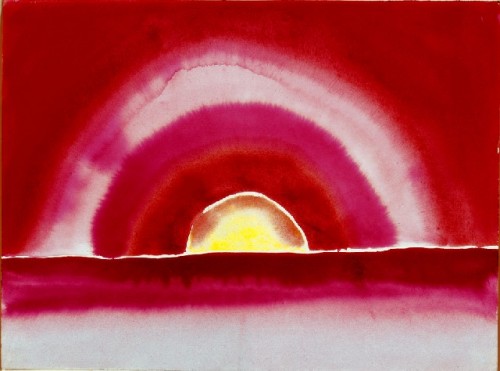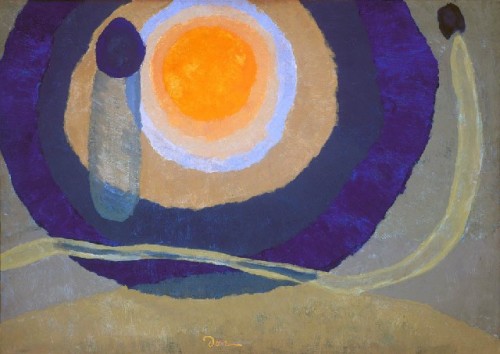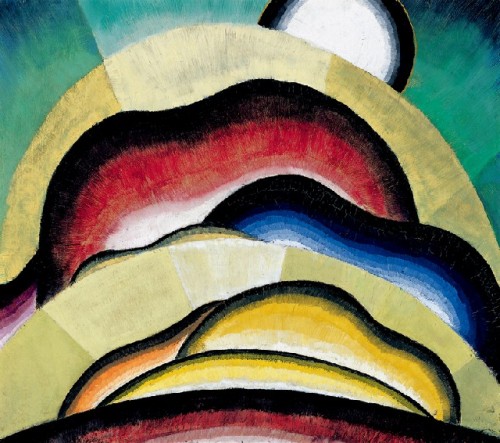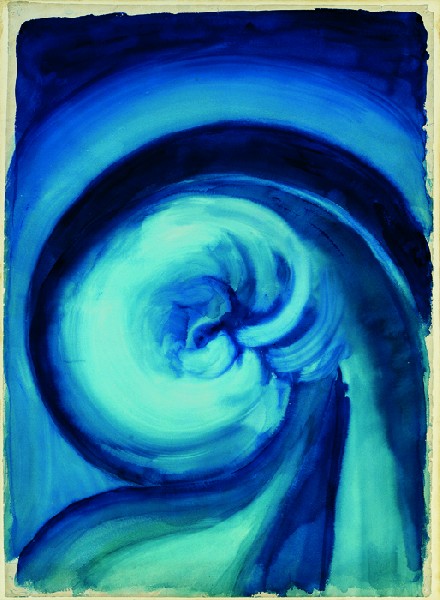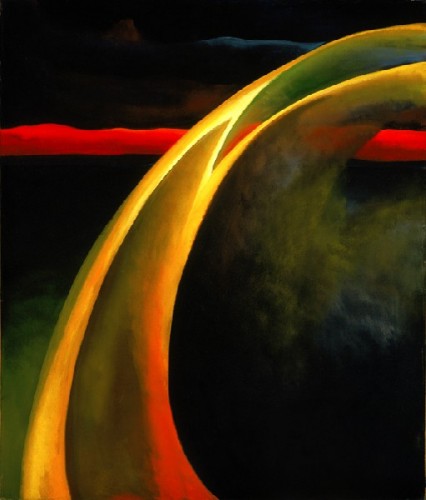Wednesday, July 18, 2012
Dove/O’Keeffe: Circles of Influence
The life and work of Georgia O’Keeffe have fascinated critics, scholars, and art lovers alike since she burst onto the New York art scene in the early 1900s. On June 7, 2009 through September 7, 2009, the Sterling and Francine Clark Art Institute added a chapter to this story with the first exhibition to explore the role of the influential American modernist painter Arthur Dove as the key figure in O’Keeffe’s development of abstraction as a means of artistic expression. Dove/O’Keeffe: Circles of Influence featured 60 major oil paintings, watercolors, drawings, and pastels created from 1910 to the early 1940s. The Clark was the exclusive venue for this exhibition.
Among the seminal works on view were O’Keeffe’s Dark Abstraction (1924)
and Jack-in-The Pulpit No. VI (1930),
and Dove’s Moon (1935)
and Fog Horns (1929).
Although Dove and O’Keeffe’s approach to imagery ultimately diverged, their shared interest in capturing the ephemeral, fugitive traits of nature—the play of light on water, the transitions of the sun and moon, and the rustle of the wind through grass—was the basis for an abiding commitment to each other’s works and a profound aesthetic connection that lasted throughout their lifetimes.
“Georgia O’Keeffe has captured the imagination of art lovers around the world, not only by virtue of her incredible talent, but through her bohemian spirit as well,” said Clark director Michael Conforti. “The Clark is excited to look for the first time at O’Keeffe’s early modernist work along with the work of the extraordinary artist Arthur Dove, examining their shared influence on each other’s works.”
From the start of her career, O’Keeffe credited a reproduction of a Dove pastel as her introduction to modernism. Dove’s use of sensual, abstract forms to evoke the flowing rhythms and patterns of nature had already put him at the forefront of the American modernist movement by the time O’Keeffe entered the scene around 1916. Dove had been featured at the renowned photographer Alfred Stieglitz’s New York gallery “291” in 1912, and O’Keeffe’s work was first shown there in 1916. Works from this period, including Dove’s Abstraction, No. 3 (1910-11) and O’Keeffe’s No. 24-Special/No. 24 (1916-17), established the innovative aesthetic vision that characterized their early work.
During the 1920s and 1930s, critics began to take serious note of the two artists as major American modernist painters. In particular, the critics began to read the paintings from a Freudian point of view, pairing Dove and O’Keeffe as representative of the “masculine” and “feminine.” Unlike Dove, O’Keeffe reacted strongly against these psychoanalytic readings of her work, arguing for a more formal interpretation. Dove, always a strong and vocal supporter of O’Keeffe, ultimately used the Freudian interpretation in defense of O’Keeffe’s work.
O’Keeffe’s influence on Dove can be seen in the 1930s, when he turned to her early works, particularly her watercolors, such as Sunrise (1916), as means through which to renew his own work and vision.
Although O’Keeffe had long abandoned the medium, Dove created a number of important works including Sunrise #1 (1936) during this period, when he found his inspiration in what he called O’Keeffe’s “burning watercolors.”
The paintings from the exhibition will be drawn from international public and private collections. The exhibition featured works once owned by Alfred Stieglitz, O’Keeffe’s husband and Dove’s longtime friend, as well as works from the Georgia O’Keeffe Museum. This exhibition was funded in part by the National Endowment for the Arts and by an indemnity from the Federal Council on the Arts and the Humanities.
The exhibition was organized by the Clark and was curated by Debra Bricker Balken, an independent curator specializing in American modernism and contemporary art who organized a Dove retrospective in 1997.
More images from the exhibit:
Arthur Dove, Sunrise, 1924. Oil on panel, 18 1/4 x 20 7/8 in. Milwaukee Art Museum. Gift of Mrs. Edward R. Wehr [Milwaukee Art Museum (photo by John R. Glembin); Courtesy of and copyright The Estate of Arthur Dove / Courtesy Terry Dintenfass, Inc.]
Georgia O’Keeffe, Blue I, 1916. Watercolor on paper, 30 7/8 x 22 1/4 in. Private collection [(c) 2009 Georgia O’Keeffe Museum / Artists Rights Society (ARS), New York]
Georgia O’Keeffe, Red & Orange Streak, 1919. Oil on canvas, 27 x 23 in. Philadelphia Museum of Art. Bequest of Georgia O’Keeffe for the Alfred Stieglitz Collection, 1987 [Courtesy of the Philadelphia Museum of Art]
More Images Here
The Clark published an exhibition catalogue authored by Balken and distributed by Yale University Press. This will be the first publication to focus on the relationship between Dove and O’Keeffe and explores the nature of art criticism in the early twentieth century as it related to psychoanalytic thought and formalism.
The Clark
Set amidst 140 acres in the Berkshires, the Clark is one of the few major art museums that also serves as a leading international center for research and scholarship. In addition to its extraordinary collections, the Clark organizes groundbreaking exhibitions that advance new scholarship and presents public and educational programs. The Clark’s research and academic programs include an international fellowship program and conferences. The Clark, together with Williams College, sponsors one of the nation’s leading master’s programs in art history.
In June 2008, the Clark opened Stone Hill Center, the first phase of its expansion and campus enhancement project. Designed by Tadao Ando, the 32,000-square-foot, wood-and-glass building houses two galleries, a meeting and studio art classroom, an outdoor café, and the Williamstown Art Conservation Center. The second phase of the expansion includes the creation of another stand-alone building by Ando that will house exhibition galleries, visitor services, and education and conference spaces. Scheduled for completion in 2013, Phase II also encompasses the upgrade and internal expansion of the Clark’s current buildings by Annabelle Selldorf.




